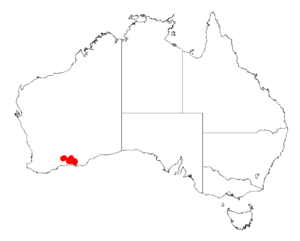Acacia profusa facts for kids
Quick facts for kids Acacia profusa |
|
|---|---|
| Scientific classification | |
| Genus: |
Acacia
|
| Species: |
profusa
|
 |
|
| Occurrence data from AVH | |
Acacia profusa is a type of shrub that belongs to the Acacia plant family. It is found only in the southwestern part of Australia. This means it is endemic to that area, growing naturally nowhere else in the world.
Contents
What Does Acacia profusa Look Like?
This upright shrub usually grows to be about 0.3 to 0.9 meters (1 to 3 feet) tall. It can grow in a dense, compact way or be more open. Its stems and leaves are glabrous, which means they are smooth and hairless. Sometimes, they can also be a bit sticky, like they have resin on them.
Leaves and Flowers
Like many Acacia species, Acacia profusa does not have true leaves. Instead, it has special flattened stems called phyllodes. These phyllodes are evergreen, meaning they stay green all year. They are crowded together and stand upright or slightly angled.
The phyllodes are grey-green and shaped like narrow lines. They can be straight or slightly curved. Each one is typically 5 to 20 millimeters (0.2 to 0.8 inches) long and 1 to 1.5 millimeters (0.04 to 0.06 inches) wide. They have three main veins, and a central vein that is either hidden or barely visible.
This plant blooms from September to October, producing bright yellow flowers. The flowers grow in small, simple clusters called inflorescences. These clusters are shaped like spheres, about 4.5 to 5 millimeters (0.18 to 0.2 inches) across. Each flower-head contains 10 to 17 golden-colored flowers.
Seed Pods
After the plant flowers, smooth, papery seed pods begin to form. These pods are narrow and oblong, growing up to 25 millimeters (1 inch) long and 10 to 12 millimeters (0.4 to 0.5 inches) wide. Inside the pods, the seeds are arranged sideways. Each seed is broadly oval-shaped and about 0.5 millimeters (0.02 inches) long.
How Was Acacia profusa Discovered?
The plant was first officially described by a botanist named Bruce Maslin in 1999. A botanist is a scientist who studies plants. Maslin included his description in a scientific paper titled Acacia miscellany. The taxonomy of fifty-five species of Acacia, primarily Western Australian, in section Phyllodineae. This paper was published in a scientific journal called Nuytsia.
Later, in 2003, another botanist named Leslie Pedley reclassified the plant and gave it a new name, Racosperma profusum. However, in 2006, it was moved back to the Acacia genus, which is its current classification.
Where Does Acacia profusa Grow?
Acacia profusa is found naturally in a specific part of Western Australia. This area stretches from around Lake Grace in the northwest to Esperance in the southeast. It grows in regions known as the Wheatbelt and Goldfields-Esperance.
You can often find this shrub growing on flat ground. It prefers soils that are made of clay, loam, or sandy-loam. Most of these plants are found between Frank Hann National Park and Peak Eleonora (south of Norseman) in the north, and Mount Ridley (north of Esperance) in the southeast. Here, it grows as part of open dwarf shrublands, shrub mallee, or low heath plant communities.

